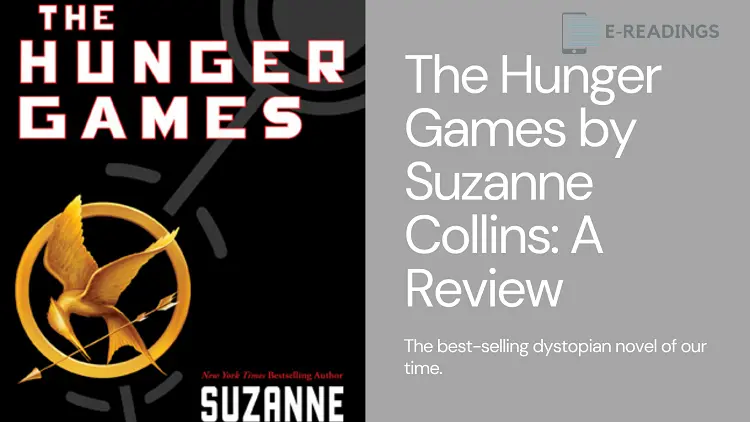This book was a gripping journey into Suzanne Collins’ ‘The Hunger Games ‘, immediately transporting me into a dystopian world that felt hauntingly familiar yet eerily alien. Pages turned into a tunnel and led me into Panem, a country subjugated against the capital. This chillingly envisioned world was spun by Collins, wherein Katniss emerged as an icon of defiance. The wildness of these games captured my heart. She was volunteering for the deadly annual Hunger Games, expressing her uncensored emotion. Tension in narration caused discomfort that ran into my stomach and was as intense as in the story. So, this was an exciting journey through the story of sacrifice and resistance. Read best Young Adult Fantasy Romance Books.
The Hunger Games by Suzanne Collins Review:
The Hunger Games by Suzanne Collins was released in September 14, 2008, and it is a suspenseful dystopian novel that involves the reader straight into the harsh reality of Panem. With time, I entered Collins’ description of a society in a state of divide governed by a capitol, and it turned out to be a fascinating adventure. In this environment saturated with despair and hopelessness, the glare becomes brighter and more brilliant by the day.

It starts shining strongly as it shows its glaring face when Katniss goes ahead and volunteers herself for the cruel games instead of her sister. In this respect, Collins superbly elides the boundaries of humour and terror, making consumers deal with inescapable facts on power, control, and human depravity. Pacing is the heartbeat of the book that takes one inside Katniss’s battle for life and the beginnings of rebellions against the Capitol. Moreover, this book won many prizes from 2008 to 2011 Hunger Games goes beyond the ordinary YA fiction, delving into the societal issues that make it an exciting read even today. You can also check Flesh and Fire Series by Jennifer L. Armentrout.
Book Summary:
In “The Hunger Games,” by Suzanne Collins, Katniss turns into a light of hope in the broken world of Panem, where one is subordinate to another. Using Greek mythology and inspired by modern-day reality television, the narrative tells a story of survival vs. rebellion. The secondary characters of Peeta, Gale, Effie, and Haymitch contribute further depth. At the same time, the annual Hunger Games is depicted as an ominous symbol highlighting the Capitol’s control of all its affairs.
In the last chapters, the writer wraps up the plot, questions left unanswered, and the fate of victory. Violence leads to controversies which reflect on its necessity of importance. The story details the system within Panem that showcases different shades, such as power, revolt, and the psychological torture of tributes. The thrilling and evocative story is also more interesting as various theories are debunked.
| Publisher | Scholastic Press |
| Publishing Date | September 14, 2008 |
| Language | English |
| Hardcover | 384 Pages |
| ISBN-10 | 0439023483 |
| ISBN-13 | 978-0439023481 |
Theme of the Book:
Survival and Sacrifice:
The Hunger Games is set within an arena that places individuals in challenging circumstances to survive, requiring them to use all their instincts and make life-or-death decisions. Life is not easy, and it involves much hard fighting, which is what the narrative illustrates.
Rebellion and Defiance:
The rebellion of a nation against an oppressive regime is one key theme. By doing so, Katniss Everdeen becomes a sign of rebellion against the Capitol. This is an account of human defiance, a reminder that even under circumstances beyond one’s control, human beings can remain steadfast.
Social Inequality and Oppression:
Social inequality and oppression are exhibited in the dystopic world of Panem. The society depicts an unrealistic contrast in terms of the economy between the affluent Capitol and the poor districts, reminding the reader of the consequences of an out-of-control regime.
Media Manipulation:
Media also strengthens the Capitol’s control, for example, through television in the Hunger Games. Its focus is on media distortion and propaganda, their effect on public perception, and their relevance to today’s society.
Morality and Ethical Dilemmas:
It presents various moral questions and ethical issues, particularly in the Hunger Games. Readers are forced to think about moral relativism in the face of extraordinary situations as characters struggle with the ambiguity between right and wrong.
The Cost of Freedom:
Chasing for independence has a price, and the story deals with the aftermaths of opposition. Indeed, the Games do not pass for victors who come up with just physical scars but carry out psychological toll, showing the continued cost of freedom search.
Identity and Self-discovery:
The characters change identities and undergo self-exploration amid Hunger Games challenges. The arena becomes an incubator that molds and transforms identities as people deal with their fears, weaknesses, and strong points.
Love and Relationships:
Incorporating themes such as survival and rebellion, it unravels the intricacies of love. Emotional content in the tale is aided by the connection among characters, particularly the changing state between Katniss, Peeta, and Gale.
What inspired The Hunger Games?
Suzanne Collins’ Inspiration:
It is the genesis of “The Hunger Games,” from the mixture of diverse social critique with elements of Greek mythology. She used the story of Theseus and the Minotaur as an analogy while delivering a sharp critique of society’s fixation on reality television.
Influences from Greek Mythology and Reality Television:
The complex base comprised the imaginary maze where tributes ventured into a dangerous path similar to that followed by Theseus and the high risk involved in the real-life reality TV competition.
The Dystopian World of Panem:
These diverse influences created a dystopia called Panem – a country comprising thirteen districts ruled mercilessly under the yoke of the Capitol. This strong background presents ideas such as oppression, inequality, and rebellion against the ruling authorities brought up vividly through the conflict between wealth and want.
The Significance of the Hunger Games:
Every year, there is an elaborate televised ceremony known as the Hunger Games where each tribute sacrifices their life to ensure the other wins. Moreover, this adds more dimension to the story by showing the extent to which the Capitol dominates power.

Characters:
Katniss Everdeen:
As a reluctant heroine, Katniss displays unwavering perseverance, inadvertently representing resistance against the tyranny of the capital.
Peeta Mellark:
Peeta’s selfless trait makes him a critical ally to Katniss in the novel, adding emotional depth to the narrations.
Gale Hawthorne:
His resolute friendship with Katniss and his membership in District 12 makes the story more complex and multi-layered.
Effie Trinket:
With a wild style, Effie symbolizes the absurdity and remoteness of the Capitol from the problems of the districts’ inhabitants’.
Haymitch Abernathy:
A highly complex mentor with a shady history named Haymitch also helps Katniss and Peeta overcome their problems associated with the game.
The Hunger Games Book Series Order:
Suzanne Collins’ “The Hunger Games” series is one of those great works of literature that leaves the reader hooked from beginning to end. The series starts with the eponymous first book, an epic quest for survival, revenge, and the human heart.
- Book 0: The Ballad of Songbirds and Snakes (First published May 19, 2020)
- Book 1: The Hunger Games (September 14, 2008)
- Book 2: Catching Fire (September 1, 2009)
- Book 3: Mockingjay (August 24, 2010)
Famous Quotes:
- You love me. Real or not real?” I tell him, “Real”
- You don’t forget the face of the person who was your last hope.
- It means thanks, it means admiration, it means good-bye to someone you love.
- “Remember, we’re madly in love, so it’s all right to kiss me anytime you feel like it.”
- “I wish I could freeze this moment, right here, right now and live in it forever.”
FAQ’s (Frequently Asked Questions):
Why are the Hunger Games held?
Hunger games serve as instruments of subjugation since they force districts to offer their kids who become sacrificial victims to the Capitol.
How are the tributes selected?
The Reaping is a lottery where everyone district presents a male and a female tribute.
What is the significance of Mockingjay?
It adopts the mocking jay as its symbol, which is an expression of the willpower and spirit that drive it in its effort to resist the oppressive rule of the Capitol.
What happens to the victors?
Victors continue to suffer the injuries they obtained while competing leading to physical and mental traumas thereafter.
Conclusion:
In sum, Suzanne Collins’s “The Hunger Games” studies a distorted society beyond traditional YA fiction. Katniss’s emotional yet brave trek turns into a representation of resistance towards the brutal Capitol. This successful merger by Collins has spawned the existence of Panem with its harsh division into the eleven districts and the chilling meaning behind the yearly hunger games held. The book’s timelessness arises from the supporting characters, climactic resolution of the plot, and emotional effect on the audience.
The novel also raises questions about power and the ability or inability of a collective body to rebel against it; human nature and the existence of a totalitarian regime as well as its atrocities become highly relevant. The uncertainty surrounding the fate of Cinna makes the series more mysterious, hence remaining on our minds for a long time.
